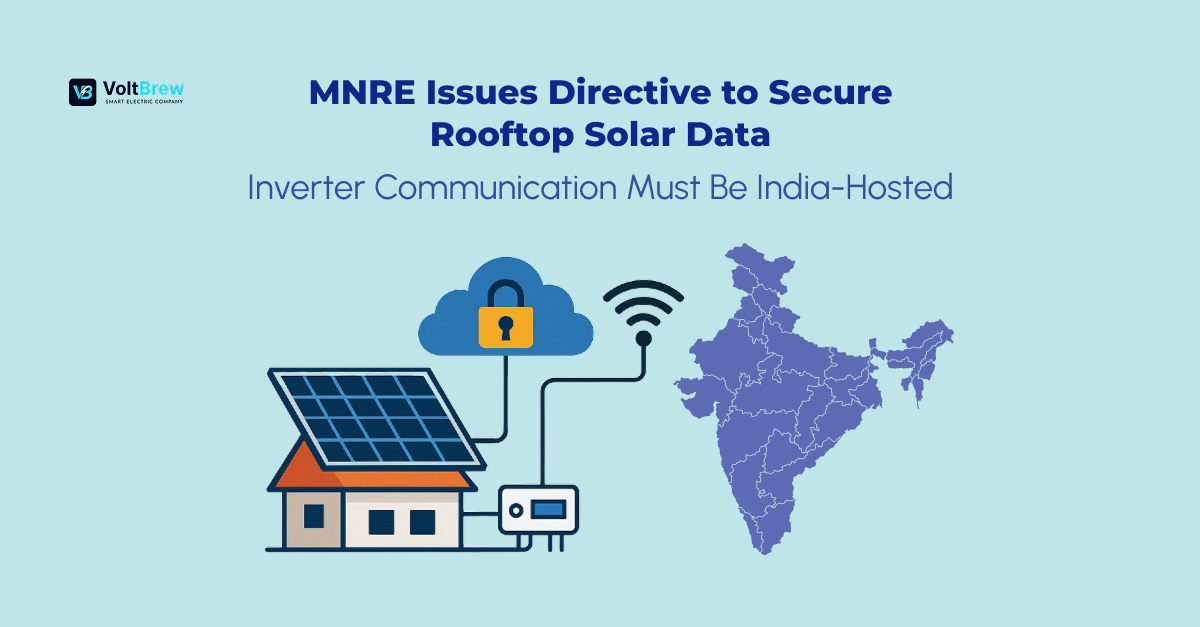In a major policy move aimed at enhancing India’s energy security, the Ministry of New and Renewable Energy (MNRE) has issued a compliance rule. It requires all inverter communication devices deployed under the PM Surya Ghar: Muft Bijli Yojana (PMSG: MBY) to route operational data exclusively through servers located within India.
The Office Memorandum, dated July 21, 2025, marks a significant shift in how India plans to govern its distributed solar infrastructure. This comes as the government accelerates efforts to deploy rooftop solar systems across one crore households. The goal is to add 30 GW of capacity under the national scheme.
The Risk Beneath the Rooftops
At the heart of the new policy lies a growing concern around cybersecurity and grid stability. Inverters, once passive devices converting DC to AC, have evolved into smart, internet-connected nodes capable of transmitting real-time data to cloud-based monitoring platforms. Original Equipment Manufacturers (OEM) typically host these platforms on servers outside India and maintain full control over their operation.
This architecture, according to the MNRE, introduces significant cybersecurity vulnerabilities.
“Inverter communication modules that transmit data to servers outside India not only pose risks of unauthorized control but also threaten national energy sovereignty,” the memorandum states.
As India moves deeper into a digital energy transition, policymakers are sounding the alarm. They warn that storing or manipulating critical energy data in foreign servers poses serious risks to grid security and national control.
The Mandate: What’s Changing
The directive lays out three major requirements:
- Secure Communication via M2M SIMs:
All inverter communication devices must adopt Machine-to-Machine (M2M) SIM technology to ensure encrypted, isolated data transfer over telecom networks effectively phasing out reliance on unregulated Wi-Fi or cloud channels. - Data Localization through a National Software Platform:
MNRE now mandates that OEMs connect their rooftop solar inverters to a centralized software platform, hosted on Indian servers, to ensure real-time monitoring, insights, and control remain under government supervision. - Standardization and Interoperability
A vendor-neutral communication protocol is currently being finalized by the ministry. Integration testing for compliance will begin on September 1, 2025. Further implementation timelines will be shared through a separate notification.
What It Means for the Industry
For OEMs, the directive will necessitate immediate technical changes in firmware, communication architecture, and backend integration with government platforms. The government will delist non-compliant devices from the PMSG: MBY scheme, making them not eligible for subsidy-linked deployment.
System integrators and EPCs (Engineering, Procurement, and Construction players) must account for extra lead time for testing and certification. EPCs must ensure stable M2M connectivity by working with telecom providers, especially in rural areas.
Consumers, however, are unlikely to see any disruption. The MNRE’s framework is designed to operate behind the scenes, with no additional steps required from people using rooftop solar
This isn’t just a technical compliance update; it’s a foundational shift in how India governs its clean energy systems. The government must maintain direct control over grid-connected assets in the digital energy landscape.
A Global Outlier in a Critical Space
India now joins a select group of countries mandating domestic data routing for distributed solar systems. Unlike the U.S. and Europe, India’s rooftop solar policy favors centralized control of smart inverters and energy data.
Cybersecurity experts have repeatedly warned about the dangers of unsecured inverter fleets. These risks grow as energy systems become targets in geopolitical conflicts.
“The integrity of our grid now depends as much on code as it does on copper,” said a senior energy policy analyst from a Delhi-based think tank. “MNRE’s move is timely, and frankly, essential.”
The Road Ahead
The Ministry has committed to publishing detailed technical specifications and integration protocols ahead of the September testing phase. The Ministry of New and Renewable Energy has directed REC Limited, the nodal agency for PMSG: MBY, to ensure compliance in all upcoming procurement and monitoring activities.
| Milestone | Expected Date |
| Final Protocol Release | August 2025 (expected) |
| Integration Testing Starts | September 1, 2025 |
| Enforcement of Data Routing Rules | Date to be announced |
Conclusion: Sovereignty at the Core of Energy Transition
As India’s rooftops turn into power plants, this policy makes it strongly clear: energy transition is not just about kilowatts, it’s about who owns the data, who controls the devices, and who safeguards the grid.
By putting national control, clear rules, and data safety at the center of its clean energy rollout, India may well be creating a blueprint that other nations will follow. It is a model where renewable energy is not only green, but also secure, independent, and future-ready.



